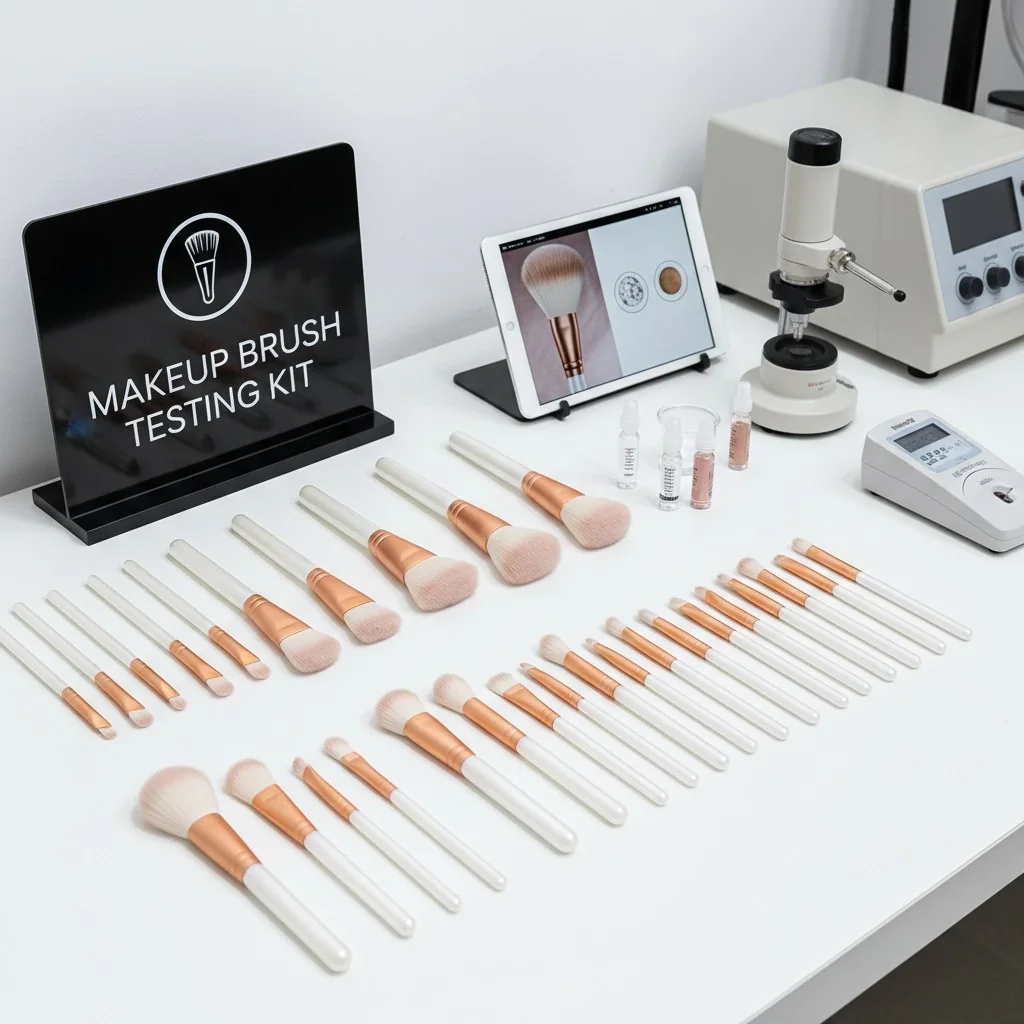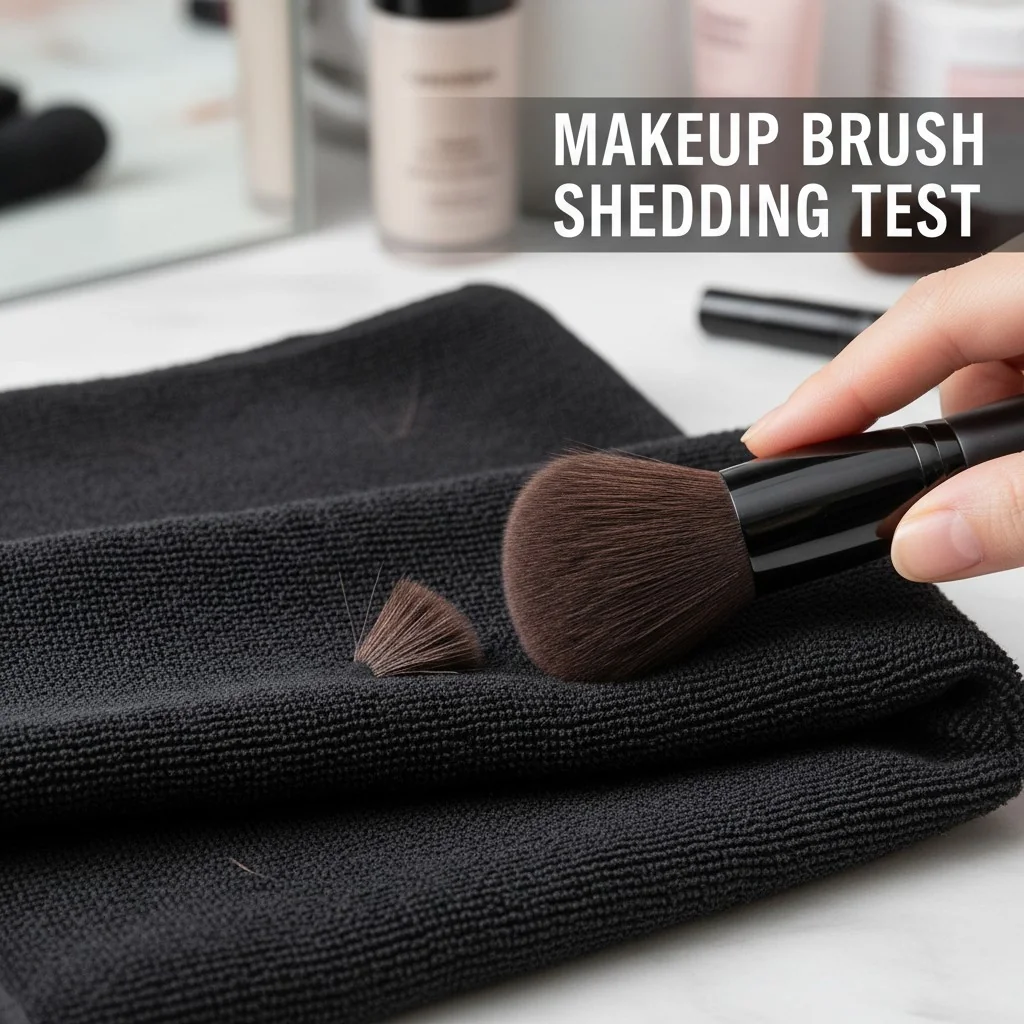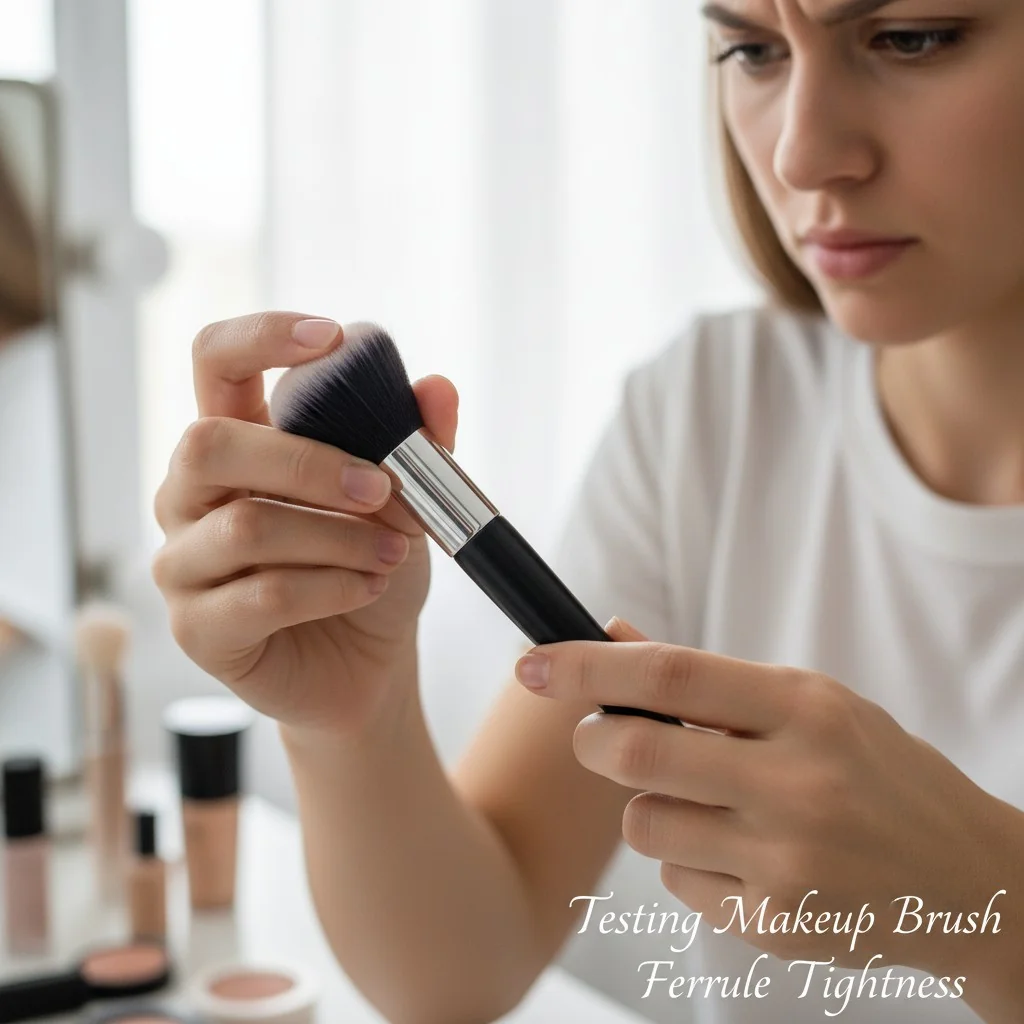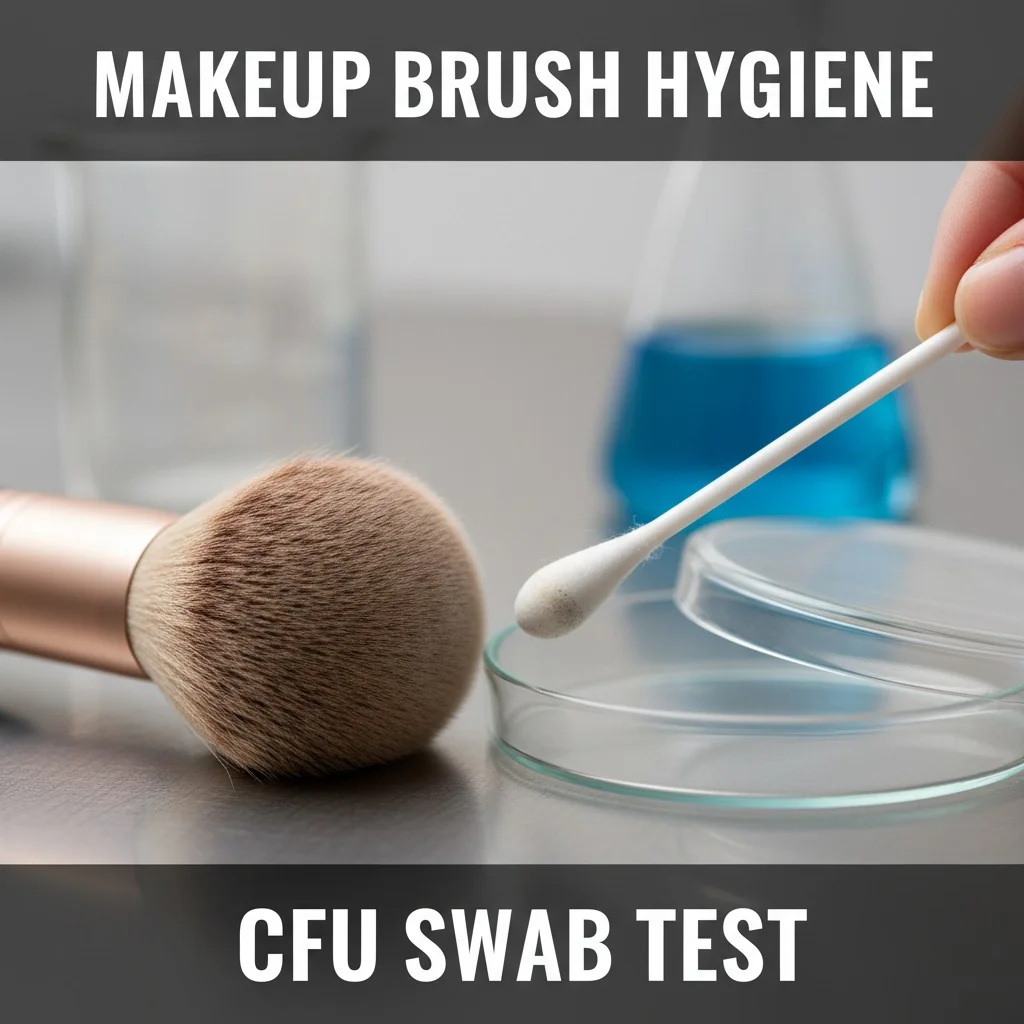Approving a bad batch of brushes can damage your brand’s reputation. You need a reliable way to test quality, but most advice is vague. Here are simple, measurable tests.
To test a makeup brush, count shedding over 50 strokes, check for scratchiness, verify even product pickup, confirm the ferrule has zero wobble, and assess shape retention. If a brush fails any single check, you should reject it.
When I first started on the factory floor, I saw firsthand how small mistakes in production could lead to big problems for brands. A slightly loose ferrule or a bad batch of glue could mean an entire order was useless. But most brand owners don’t have access to a factory floor. They rely on samples, and they need to know what to look for. Vague advice like "it should feel good" isn’t enough when your money and reputation are on the line.
That’s why I developed a system of simple, repeatable tests that anyone can perform. These aren’t just theories; they are the exact checks we use to ensure quality before a single brush leaves our facility. This guide will walk you through these tests, giving you the power to approve supplier lots with confidence and stop guesswork for good.
Natural hair brushes are designed to shed a few bristles during the first few uses.True
Due to the nature of animal hair, some initial shedding is normal. High-quality manufacturing processes aim to minimize this, but a few loose hairs (under 5) on first use is acceptable.
All synthetic bristles are vegan and cruelty-free.False
While synthetic bristles themselves are not animal-derived, the finished brush is only cruelty-free if no animal testing occurred during development and no animal-derived components (like certain glues) were used in the handle or assembly.
Performance: The 7-minute table test that catches 90% of brush defects?
Your customer’s first impression is everything. A brush that sheds or applies makeup poorly reflects badly on your brand. You need a quick, reliable way to spot these performance issues.
This simple 7-minute test checks the four most critical performance factors1: shedding, softness, application, and shape retention. It requires minimal equipment and gives you a clear pass/fail result, catching most defects before they ever reach your customers.
I created this "table test" because I saw so many clients like Emily struggle with inconsistent samples. They would approve one good brush, only to receive a bulk order where half the brushes were scratchy or shed like crazy. This test standardizes the process. It takes the "feeling" out of it and replaces it with data. It’s fast enough to run on a batch of samples in under an hour, giving you the confidence to approve or reject an order.
The Four Core Performance Checks
These tests should be performed in order. If a brush fails any one of these steps, it doesn’t meet professional quality standards.
| Test | Protocol | Pass/Fail Criteria |
|---|---|---|
| 1. shedding count2 | Stroke the brush 50 times with light pressure on a dark microfiber towel. | Pass: ≤1 bristle for synthetic; ≤5 for natural. |
| 2. Softness & Scratch | Gently stroke the brush head across the sensitive skin of your inner wrist. | Pass: No scratchy or prickly sensation. Any scratchiness is an immediate fail. |
| 3. Pickup & Blending | Swirl the brush in a standard powder pan. Apply to a silicone face chart or the back of your hand in 10 circular motions. | Pass: Product is picked up evenly. No visible streaks remain after blending. |
| 4. Splay & Shape | Photograph the brush head. Stroke it firmly 30 times on a surface. Gently reshape with your fingers and photograph again. | Pass: The brush head returns to its original shape. Splay (widening) is less than 10% of the original diameter. |
A makeup brush's performance depends entirely on the type of hair used.False
While hair type is crucial, performance also depends on the density, cut, and shape of the brush head. A poorly shaped brush with high-quality hair will still perform badly.
Silicone face charts are an industry-standard tool for testing makeup application.True
Silicone charts provide a consistent, non-porous surface that mimics skin texture, allowing for objective evaluation of product pickup, blending, and streaking without the variability of human skin.
Build quality: Ferrule, glue, handle—how to spot failures before your first order?
A beautiful brush that falls apart after a week is a liability. Poor build quality is a common failure, but the warning signs are often missed. You need to know how to check.
Look for a tight ferrule, a clean glue seal, and a balanced, flawless handle. These three areas are where manufacturers often cut corners, leading to wobbly heads, loose bristles, and a cheap feel.
I’ve seen it all: ferrules that pop right off, handles with cracked paint, and visible globs of glue around the bristles. These are not just cosmetic issues; they are signs of a rushed, low-quality assembly process. A good supplier takes pride in these details. For example, we use high-quality brass or aluminum for our ferrules and a precise crimping process to ensure a rock-solid connection. Checking these three simple points can tell you almost everything you need to know about the factory’s attention to detail and the long-term durability of the brush.
The Three-Point Construction Audit
A brush should feel like a single, solid tool. Any weakness in its construction is a red flag.
-
ferrule tightness3: Hold the handle in one hand and the metal ferrule in the other. Gently try to twist and wiggle the ferrule. There should be absolutely zero movement or sound. A wobble indicates a poor crimp or insufficient glue, and the brush will eventually fall apart. High-quality ferrules, typically made of brass or aluminum, should feel completely rigid and seamless with the handle.
-
Glue Seal Inspection: Look closely at where the bristles enter the ferrule. You should not see any visible glue overflow on the bristles or gaps at the ferrule’s edge. Clean glue lines are a sign of a precise, automated assembly process. Messy glue suggests manual error and a higher risk of bristle loss over time.
-
Handle Finish & Balance: Roll the handle on a flat surface to check for straightness. Inspect the finish under bright light for any chips, cracks, or inconsistencies in the paint or coating. Finally, balance the brush on your finger. A well-designed brush should balance near the ferrule, which gives the user better control during application. A handle-heavy brush can feel clumsy and lead to user fatigue.
Brass ferrules are always better than aluminum ferrules.False
While brass is heavier and often perceived as more luxurious, high-grade aluminum is lightweight, corrosion-resistant, and can be crimped just as securely. The choice depends on the desired weight, balance, and cost of the brush.
The balance point of a makeup brush is a key factor in its ergonomic design.True
Professional makeup artists and product designers agree that a balance point near the ferrule provides greater control and precision, reducing hand fatigue during extended use.
Hygiene & durability: Simple CFU swabs and 30-wash endurance your team can run?
Your brand is responsible for product safety and longevity. A brush that harbors bacteria or degrades after a few washes is a risk. You need a way to verify hygiene and durability claims.
You can run simple in-house tests like CFU swabs to screen for contamination and a 30-wash cycle test to check endurance. These protocols help you validate antibacterial claims and ensure your brushes last.
Many brands want to claim their brushes are "antibacterial," but they have no data to back it up. This is a huge risk. In manufacturing, we follow strict Good Manufacturing Practices4 (GMP), like those outlined in ISO 22716, to prevent contamination from the start. But as a brand owner, you should also verify the final product. A simple CFU swab test, which you can do in-house with a basic kit or send to a third-party lab, provides real data. The same goes for durability. We simulate long-term use with a standardized wash test to ensure the glue, handle finish, and bristles hold up.
In-House Protocols for Safety and Longevity
These tests simulate real-world use and help you verify supplier claims.
-
hygiene screen5 (CFU Swab): For a basic in-house screen, you can use a sterile swab to sample the brush head and transfer it to a pre-poured agar plate. Incubate it according to the kit’s instructions and observe for colony growth. For official antibacterial claims, you must use a third-party lab to get quantifiable data, such as a percentage reduction in colony-forming units (CFUs) after cleaning. This aligns with professional hygiene standards and protects your brand from making unsubstantiated claims.
-
wash-cycle endurance6: This test checks how the brush withstands repeated cleaning.
- Protocol: Wash the brush 30 times using lukewarm water and a gentle, sulfate-free cleanser.
- Method: Gently massage the bristles, rinse thoroughly until the water runs clear, and squeeze out excess water. Reshape the head and lay the brush flat to air dry. Never use hot water or a blow dryer, as heat can melt the glue and damage the bristles.
- Evaluation: After 30 cycles, check for increased shedding, a loose ferrule, or any damage to the handle’s finish (peeling, clouding). The brush should perform just as well as it did in the initial 7-minute test.
-
Cleanser Compatibility: Test the brush with common cleaning agents, including brush shampoos and mild detergents, to ensure the bristles don’t clump and the handle’s finish doesn’t become cloudy or tacky.
ISO 22716 is a mandatory certification for all makeup brush factories.False
ISO 22716 provides guidelines for Good Manufacturing Practices (GMP) in the production of cosmetics. While it is the global standard and highly recommended, it is not a mandatory legal requirement in all countries. However, reputable factories align with its principles.
Washing makeup brushes with hot water helps kill more bacteria.False
Hot water can melt the glue that holds the bristles in the ferrule, leading to shedding and ruining the brush. Lukewarm water with a proper cleanser is effective and safe for the brush's construction.
OEM-ready: A pass/fail checklist to approve supplier lots without guesswork?
Communicating your quality standards to a factory can be difficult. Vague requests lead to inconsistent results. You need a clear, documented way to define and verify your requirements.
Provide your OEM/ODM supplier with a formal checklist that includes your pass/fail criteria, material specifications, and required documentation. This turns your quality standards into a contractual obligation.
The biggest pain point I hear from brand founders is the gap between the approved sample and the final bulk order. This happens when quality expectations are not clearly documented. When I work with a client, we don’t just send a sample; we send a full data sheet with it. This sheet includes shedding counts, ferrule torque test results, and material disclosures. By requiring your supplier to provide this same level of data for every production lot, you create a system of accountability. It forces the factory to maintain standards and gives you a clear, objective reason to reject a batch if it doesn’t meet the agreed-upon specifications.
The Essential OEM/ODM Quality Checklist
Use this checklist as a template for your supplier agreements. Require them to provide this information with every shipment.
| Category | What to Request from Your Supplier | Why It’s Important |
|---|---|---|
| 1. Sampling Data | Request lot-specific test results for shedding counts, ferrule pull/torque tests, and wash-cycle endurance. For antibacterial brushes, ask for a Certificate of Analysis (COA) from a third-party lab. | This provides objective proof that the bulk order meets the same quality standards as the approved sample. |
| 2. materials disclosure7 | Require a full Bill of Materials (BOM) detailing the bristle type (e.g., PBT synthetic, grade A goat hair), ferrule metal (brass, aluminum), glue type (e.g., epoxy resin), and handle materials/coatings. | This ensures material consistency across batches and allows you to verify claims like "vegan" or "sustainably sourced." |
| 3. Standards & Certs | Ask for proof of alignment with GMP standards (like ISO 22716). Request copies of any certifications they claim, such as FSC (for wood handles), Vegan, or Cruelty-Free. | This verifies their commitment to a clean and ethical manufacturing environment. It protects your brand from false advertising. |
| 4. QC Tolerance Windows | Provide your supplier with your written pass/fail criteria (e.g., "shedding count must be ≤1 bristle"). Require them to agree to these tolerances and outline a corrective action plan for failed lots. | This makes your quality expectations a binding part of the agreement and clarifies the process for handling defects. |
All factories in China can provide ISO, FSC, and Vegan certifications upon request.False
These certifications require rigorous audits and investment. Many smaller or less reputable factories do not have them and may provide fake documents. Always verify certifications through the issuing body.
A Bill of Materials (BOM) is a standard document in professional manufacturing.True
A BOM is a comprehensive list of all raw materials, components, and assemblies required to build a product. It is essential for quality control, supply chain management, and cost calculation.
Conclusion
By using these measurable tests and a clear OEM checklist, you can take control of your product quality, protect your brand, and build a lasting partnership with your supplier.
References
-
Identifying performance factors helps in selecting high-quality brushes that meet customer expectations. ↩
-
The shedding count test is essential for evaluating brush quality and ensuring customer satisfaction. ↩
-
Ferrule tightness is a key indicator of brush durability and quality, impacting overall performance. ↩
-
Understanding GMP is crucial for ensuring safe and high-quality cosmetic products. ↩
-
Conducting a hygiene screen ensures product safety and helps prevent bacterial contamination. ↩
-
Testing wash-cycle endurance is vital for verifying the durability and longevity of makeup brushes. ↩
-
Materials disclosure ensures consistency and transparency, protecting your brand’s integrity. ↩







